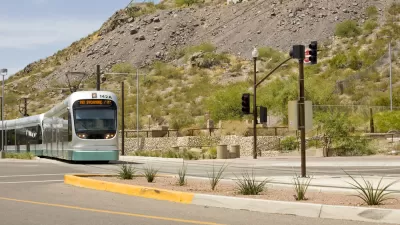As Wellington 'Duke' Reiter notes, for the past several decades Phoenix has shown it expertise in horizontal growth. But, as development heats up again after the Great Recession, he says the city's growth must be managed to increase density.
Reiter, the senior vice president of the ASU Foundation and vice chairman of the Urban Land Institute Arizona, summarizes the discussion as a recent event organized by ULI Arizona called “Here We Grow Again.” "While the demographic evidence at this conference suggested that we should brace for expansion, there was a parallel and equally compelling theme featuring exactly the opposite imperative: How small can you make your city?"
Density, Reiter explains, is valued by today's business leaders, and is crucial to remaining competitive in attracting employers and employees. "Companies built on innovation are seeking a place with a sense of identity, public transportation, restaurants, cultural venues and, if at all possible, a compelling blend of the old and the new," he notes.
"The challenge for the Phoenix region is simple: Will our considerable footprint — one that has been enabled by the automobile and access to moderately priced housing, fuel and water — be our destiny? Can our archipelago of loosely coordinated municipalities compete with more cohesive offerings by other cities?"
"Most importantly, can we invest strategically and even disproportionately in key institutions and select areas that represent only a percentage of the total landmass of the Phoenix area but which could be transformative for the entire region?"
"The answer has to be yes."
FULL STORY: To grow up, Phoenix must grow small

Alabama: Trump Terminates Settlements for Black Communities Harmed By Raw Sewage
Trump deemed the landmark civil rights agreement “illegal DEI and environmental justice policy.”

Planetizen Federal Action Tracker
A weekly monitor of how Trump’s orders and actions are impacting planners and planning in America.

The 120 Year Old Tiny Home Villages That Sheltered San Francisco’s Earthquake Refugees
More than a century ago, San Francisco mobilized to house thousands of residents displaced by the 1906 earthquake. Could their strategy offer a model for the present?

Ken Jennings Launches Transit Web Series
The Jeopardy champ wants you to ride public transit.

BLM To Rescind Public Lands Rule
The change will downgrade conservation, once again putting federal land at risk for mining and other extractive uses.

Indy Neighborhood Group Builds Temporary Multi-Use Path
Community members, aided in part by funding from the city, repurposed a vehicle lane to create a protected bike and pedestrian path for the summer season.
Urban Design for Planners 1: Software Tools
This six-course series explores essential urban design concepts using open source software and equips planners with the tools they need to participate fully in the urban design process.
Planning for Universal Design
Learn the tools for implementing Universal Design in planning regulations.
Clanton & Associates, Inc.
Jessamine County Fiscal Court
Institute for Housing and Urban Development Studies (IHS)
City of Grandview
Harvard GSD Executive Education
Toledo-Lucas County Plan Commissions
Salt Lake City
NYU Wagner Graduate School of Public Service





























